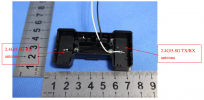cstout
Active Member
Actually just went out 14,451’ on that Omni after swapping the qma connectors (had to return due to battery, not signal). Looks like I’ve got a bad qma connector! Somewhat relieved.
Very valuable information! Looking further at some RC teardown Chinese movie I found that Black 5.8GHz seems connected to the left stock antenna and the White 2.4GHz on the right side, looking from the pilot view. I just ordered two Yagi’s for 2.4 and 5.8 respectively. I intend to cut them and install the 5.8G element on the left and 2.4 Yagi on the right, thus having a dual band Yagi setup.Opened up the remote and confirmed the leads:
W = 2.4 ghz antenna
B = 5.8 ghz antenna
For example, in LTE routers one can find a multiband primary (RX/TX) and a multiband secondary antenna (receive only). The two antennas are orthogonal and needed for the differential receive.
I have to say I was bit surprised to hear that instead of such a differential setup, the RC might use only one antenna per band.
Could you please reconfirm what exactly you have discovered during your experiments? Did you assume that W is 2.4G (single band) and the other must have been 5.8 because your 2.4 amplifier worked with W? Did I understand correctly, that now a new 5.8G amplifier also needed W?
In such case, W would be rather the multiband RX/Tx antenna and B - the secondary receiving antenna, helping RC to mitigate phase effects related to changing distance and/or radio waves’ reflections.

Thanks for sharing this. I just got my omnidirectional 5.8ghz antenna and connected it to my 5.8 amp and to the “W” connection and flew out 11,800 ft before signal loss. Nothing connected to the “B” connection. I was hoping I’d see something different flying on 5.8 only with one antenna, but at this point I’m still at a loss. No idea what the “B” connection is good for. Even if it is “receive only” I’m not sure what it’s receiving if the “W” connection is sending and receiving all necessary flight controls and video data.This photo may be of benefit. It's from DJI's filing with the FCC for approval of the Mavic Air 2 controller. It clearly shows that the white antenna is for both receive and transmit on both 2.4 and 5.8 GHz while the black antenna is a 2.4/5.8GHz receive only antenna.
In the filing, DJI states that at 2.4 GHz the antenna has 3 dBi gain (barely more than a dipole) and at 5.8 GHz the antenna has 4 dBi gain.
View attachment 121092
Thanks for sharing this. I just got my omnidirectional 5.8ghz antenna and connected it to my 5.8 amp and to the “W” connection and flew out 11,800 ft before signal loss. Nothing connected to the “B” connection. I was hoping I’d see something different flying on 5.8 only with one antenna, but at this point I’m still at a loss. No idea what the “B” connection is good for. Even if it is “receive only” I’m not sure what it’s receiving if the “W” connection is sending and receiving all necessary flight controls and video data.
Hi Jim,1. Have you tried the omnidirectional antenna, on the exact same route, without the amplifier?
2. What make and model amplifier do you have?
Best,
Jim
The RF Power meter v2 came. It seems smaller than in the pictures and makes to me an impression of being more like a tester (or a toy) rather than a real meter. I hope I will learn how to apply, interpret (and trust) the results with time.I’ve got a custom Raptor SR coming my way soon that I’m excited to test out. I’ll be sure to report back to see how it compares to the stock antenna.
Anybody make any new discoveries with the “B” antenna connection?
@Oldi001 I’m eagerly awaiting the results of your RF meter tests! Hopefully that will give some insight to whether or not anything is actually sending/receiving on that connection.
We use essential cookies to make this site work, and optional cookies to enhance your experience.

